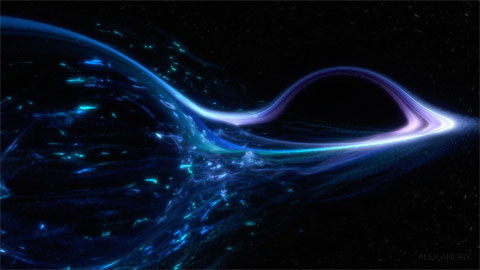Mysterious object detected to have merged with a black hole

Scientists from the LIGO and Virgo gravitational wave detection experiments, with the involvement of the IFAE at the UAB, discovered that a black hole swallowed an unidentified body, producing an intense gravitational wave.
25/06/2020
The astronomy community has been baffled for some time now by the fact that they have failed to detect any compact objects measuring between 2.5 and 5 solar masses. This mysterious grey zone is known as a "mass gap": an interval of masses too small to be a black hole and too big to be a neutron star. Both neutron stars and black holes form when super-massive stars run out of nuclear fuel and explode into supernovas. What remains after the explosion depends on what is left of the star's core. Less massive cores tend to form neutron stars, while more massive stars collapse and form black holes. Understanding whether there is a mass gap in this specific interval, and why, is an enigma troubling scientists for decades.
Now, scientific collaborations working on the Advanced Virgo detector at the European Gravitational Observatory (EGO), near the town of Pisa, Italy, and two Advanced LIGO detectors located in the USA, have announced the discovery of an object measuring 2.6 solar masses, and therefore within the "mass gap", thereby questioning its very existence. The nature of the object in itself continues to be a mystery, given that the observation of gravitational waves are not enough to distinguish whether it is a neutron star or black hole. Some 800 million light-years away, an unidentified object merged with a black hole measuring 23 solar masses and in doing so, generated a black hole measuring 25 times the size of our Sun. The resulting cosmic merger produced an intense gravitational wave which was detected by the three instruments on 14 August 2019, and was labelled GW190814. The discovery was recently published in The Astrophysical Journal Letters.
Another peculiarity of this event is that the cosmic merger demonstrated the most unusual proportion between objects of a binary system registered up to date. The large mass is approximately 9 time larger than the smaller mass.
The signal associated with such an unusual merger was clearly detected by the three instruments pertaining to the LIGO-Virgo network, with a global signal-sound relation of 25. Thanks to mainly to the delay between the moments in which the signal arrived to three detectors (two Advanced LIGO in the USA and one Advanced Virgo in Italy, the network of three detectors was capable of pinpointing the origin of the source of the wave within 19 square degrees.
When the scientists from LIGO and Virgo detected the cosmic merger, they immediately sent a message out to the entire astronomical community. Many terrestrial and spatial telescopes began to monitor space in search of light and others searched for electromagnetic waves, but in contrast to the famous merger of two neutron stars detected in August 2017, which gave way to the name "multi-messenger" astronomy, this time seguiment a la recerca de llum i d’altres ones electromagnètiques, però, a diferència de la famosa fusió de dues estrelles de neutrons, detectada l'agost de 2017 i que van donar lloc a l'anomenada astronomia multi-missatger, en aquest cas no es va recollir cap senyal.
According to the scientists at Virgo and LIGO, there are many possible reasons why the event occuring in August 2019 was not seen within the electromagnetic spectrum. Firstly, this event was six times farther away than GW170817, and this made the detection of any electromagnetic signal difficult. Secondly, if the collision involved two black holes, there would probably be no emissions in the electromagnetic spectrum. Thirdly, if the smaller object of that system was indeed a neutron star, its 9-times larger black hole partner could have swallowed it whole, and a neutron star being devoured by a black hole would not produce any electromagnetic emission either. Thus the identity of the object detected on 14 August 2019 remains a mystery.
In addition to testing our understanding of stellar evolution and the creation of neutron stars and black holes within this mass gap, the peculiar proportion between the two masses in this binary system and the fact that it is the gravitational waves incident most precisely located in space to not be accompanied by electromagnetic counterparts, has led to new tests on the theory of gravity and a new measuring of the Hubble constant, compatible with the one obtained through the GW170817 incident.
"The GW190814 incident is a good example of how gravitational waves have the potential radically to change how we understand the cosmos both at the level of astronomy and fundamental physics", states Mario Martínez, coordinator of the Virgo group at the Institute of High Energy Physics (IFAE). He goes on to say that, "The data gathered by the LIGO and Virgo interferometers now and with more precision in the following years will contribute to this."
Future observations by Virgo, LIGO and possibly other telescopes will be able to detect similar events and help to respond to several questions arising from the detection of GW190814.
The five groups in Spain are contributing to the gravitational waves astronomy of LIGO-Virgo, in areas ranging from theoretic modelling of astrophysic sources to the improvement in the precision of the detector for current and future observation periods. Two groups, from the University of the Balearic Islands (UIB) and the Galician Institute of High Energy Physics (IGFAE) at the University of Santiago de Compostela (USC), form part of the LIGO Scientific Collaboration (LSC); while the University of Valencia (UV), the Institute of Cosmos Sciences of the University of Barcelona (ICCUB) and the Institute of High Energy Physics (IFAE) at the UAB, are members of the Virgo Collaboration.
More information:
Video by the French artist Alex Andrix in collaboration with EGO-Virgo and LMA.
This information is related to the following SDG
Partnerships for the goals